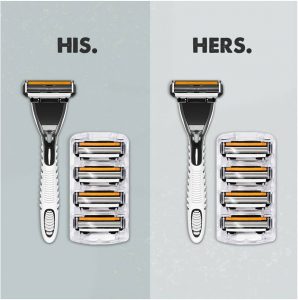
The “genderless” model of this 2014 ad campaign from the Dollar Shave Club is explicit in its implications (or non-implications). Men’s and women’s razors are typically separate from one another in terms of production. Men’s razors are often darkly toned (blue or black) and take on a slicker model defined by lines instead of curves, while women’s razors are often colored pink and shaped by its curves. These standard razors models work to imply their demographic by completely basing a product’s model on the consumers expected gender role. The Dollar Shave Club, on the other hand, shows a disregard for gender roles and expectations, and has instead decided to sell the same model to its customers, despite what their gender orientation may be. By disregarding gender norms, the Dollar Shave Club has implied an inclusive company model: they’re selling razors, not pushing gender expectations.
Not only does this ad campaign inherently create space for narratives outside of the stereotypical male and female gender experiences, it also works to desexualize those narratives. To not include any bodily representations in this ad must have been a conscious decision. From a marketing perspective, this ad campaign is not explicitly stating its market, nor it is making any further implications as to why someone should buy the product, other than its being a hair removal tool. Both of these decisions constitute a risk, seeing that there is no specifically guaranteed market, but these risks are taken, ingeniously, to state just that: the razor is a tool. The sexuality, gender identity, or presentation of the user does not actually matter—what matters is if the tool can serve as a means to its designated end. By employing such simplistic ad campaign, the Dollar Shave Club has decided to market a tool rather than sell an identity; they have stripped any possible implications from their product, relative to the user, other than the razor’s sole purpose of remove hair.
That all being said, I find it necessary to mention that the campaign itself does still imply a gender binary, although it simultaneously addresses that problem. Claiming that the same product can be used by both men and women, while avoiding a representation of the ideal consumer to the product, implies that there is no real difference between men and women. Whether this was the original intent or not makes no difference; at the end of the day, this ad campaign is only an ad campaign, but that doesn’t mean that it isn’t representational of a sort paradigm shift. This ad strays from the conventional ideology surrounding gender, and proudly professes its nuance. Alone, the fact that there is only a year in between this Dollar Shave Club campaign (2014) and the Schick campaign (2013) shows a crucial shift in ideology, especially when considering the similarities between the Schick ads and those of the early nineteenth century. With still much more work to do, this ideological change represents a general change in understanding that appears to be working towards an evermore inclusive society…
Only time will tell.